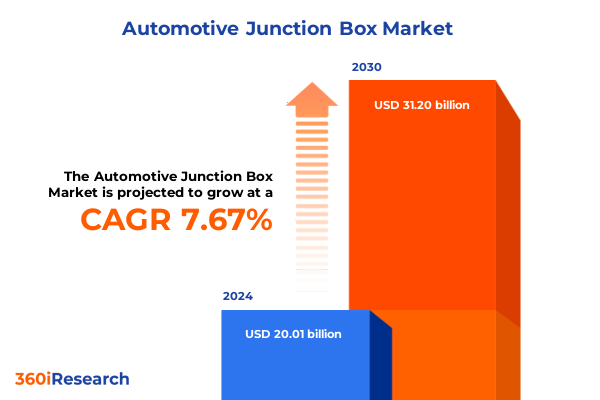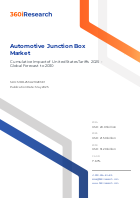The Automotive Junction Box Market size was estimated at USD 20.01 billion in 2024 and expected to reach USD 21.50 billion in 2025, at a CAGR 7.67% to reach USD 31.20 billion by 2030.

Introduction to the Pivotal Role of Junction Boxes in Modern Vehicles
The automotive junction box has emerged as a pivotal hub in modern vehicles, orchestrating the seamless distribution of electrical power and signal routing that underpins advanced functionality. As consumer expectations shift toward greater connectivity, safety, and efficiency, the junction box has evolved from a simple fuse and relay enclosure into an intelligent control center integrating sensors, microcontrollers, and load management circuits. This transformation reflects broader trends in vehicle electrification and digitalization, where reliability, scalability, and modularity are non-negotiable. In parallel, stringent emissions regulations and the accelerating adoption of electric and autonomous vehicles have heightened the demands placed on system architectures. Consequently, manufacturers and suppliers are compelled to innovate in materials, components, and design methodologies to ensure that junction boxes meet the rigorous performance and safety standards of next-generation mobility. This introduction sets the stage for a comprehensive examination of the shifts reshaping the junction box market, the ripple effects of newly implemented tariffs, and strategic imperatives for stakeholders aiming to secure a competitive advantage in a rapidly evolving automotive ecosystem.
Transformative Shifts Defining the Automotive Junction Box Landscape
Over the past decade, the vehicle electrical landscape has undergone profound shifts, driven by the integration of advanced driver assistance, infotainment, and battery management systems. Traditional passive junction boxes, once limited to housing fuses and relays, are ceding ground to smart junction boxes equipped with CAN bus interfaces and microcontroller-based control units. This shift empowers real-time diagnostics and adaptive load management, enhancing both vehicle safety and energy efficiency. Concurrently, the choice of materials is evolving; metals continue to deliver structural robustness and conductivity, while high-performance plastics enable weight reduction and design flexibility. Component architectures are also diversifying, with an increasing emphasis on modular relay boxes and plug-and-play connectivity solutions. As vehicles become software-defined and electric architectures proliferate, junction boxes will assume even greater complexity, necessitating collaboration across semiconductor, electronics, and wiring harness specialists to deliver integrated, scalable solutions.
Assessing the Cumulative Impact of United States Tariffs in 2025
The introduction of comprehensive U.S. tariffs in early 2025 has introduced a new layer of complexity for junction box manufacturers and their supply chains. Levies on imported plastics, microcontrollers, and connectors have escalated input costs, compelling firms to reassess sourcing strategies and negotiate volume contracts to mitigate pricing pressures. Component suppliers are exploring near-shoring initiatives to maintain margins and reduce lead times, while vehicle assemblers are leveraging vertical integration to internalize certain assembly processes. These measures have yielded mixed outcomes: localized production has enhanced supply chain resilience, yet scale economies remain constrained by domestic capacity and labor costs. As companies adapt to the altered cost structure, some are accelerating technology licensing agreements to secure critical semiconductor supplies, while others are investing in proprietary material formulations that circumvent tariff categories. The net effect is a market that is more regionally segmented and strategically diversified than ever before.
Key Insights Drawn from Segmenting the Junction Box Market
Analysis of market segmentation reveals nuanced growth drivers and competitive intensity across each category. When examining product type, smart junction boxes are outpacing passive variants, propelled by their integration with advanced driver assistance and connectivity systems. Within the component segment, CAN bus interfaces and microcontrollers are commanding a larger share of R&D investment, reflecting the prioritization of real-time communication and processing capabilities. Material choices further underscore a dual-track strategy: manufacturers are balancing the conductivity and thermal performance of metals with lightweight plastics that enhance fuel economy and electric range. Application areas such as battery management and safety systems are emerging as high-growth pockets, driving demand for relay boxes and load management circuits optimized for high-voltage environments. Vehicle type segmentation indicates that commercial and electric vehicles are key battlegrounds for suppliers, with heavy commercial and battery electric subsegments showing particular momentum. Finally, the aftermarket channel is witnessing robust growth, as replacement demand and retrofitting opportunities expand in tandem with connectivity upgrades.
This comprehensive research report categorizes the Automotive Junction Box market into clearly defined segments, providing a detailed analysis of emerging trends and precise revenue forecasts to support strategic decision-making.
- Type
- Component
- Material
- Application
- Vehicle Type
- End-User
Geographic Variations Driving Junction Box Demand
Regional dynamics in the junction box market are shaped by varying adoption rates of vehicle electrification, regulatory landscapes, and industrial capabilities. In the Americas, robust investment in electric vehicle infrastructure and incentives is fostering accelerated integration of high-voltage junction boxes, particularly for commercial fleets transitioning to zero emissions. EMEA countries are characterized by stringent safety and emissions standards, prompting suppliers to innovate in materials science and modular designs that meet diverse regulatory regimes across Europe, the Middle East, and Africa. The Asia-Pacific region remains the largest volume market, underpinned by mass production of passenger vehicles and rapid EV adoption in China, Japan, and South Korea. Here, local manufacturers are leveraging scale and cost advantages, while partnerships with global semiconductor and electronics firms are driving incremental technological advancements. Overall, regional specialization is deepening, with supply chains, R&D centers, and design hubs aligning to local market requirements and policy incentives.
This comprehensive research report examines key regions that drive the evolution of the Automotive Junction Box market, offering deep insights into regional trends, growth factors, and industry developments that are influencing market performance.
- Americas
- Asia-Pacific
- Europe, Middle East & Africa
Strategic Profiles and Collaborative Trends among Leading Manufacturers
A competitive analysis highlights a diverse ecosystem of global players, each leveraging unique strengths. Established automotive tier-one firms are enhancing their portfolios by integrating semiconductor capabilities and forging strategic alliances with electronics specialists. Traditional wiring harness and connector companies are expanding into control unit assembly, while semiconductor manufacturers are ramping up production of automotive-grade microcontrollers and power management ICs. Several emergent suppliers are carving niches in materials innovation and advanced plastics molding techniques. Collaboration between global technology leaders and regional champions is reshaping market hierarchies, with an emphasis on co-development and localization. Intellectual property in load management algorithms and diagnostics software is becoming a critical differentiator, and firms with comprehensive aftermarket networks are well-positioned to capture retrofit opportunities. The competitive landscape is defined by convergence-where electronics, materials, and software expertise unite to deliver next-generation junction box solutions that meet escalating performance, safety, and reliability demands.
This comprehensive research report delivers an in-depth overview of the principal market players in the Automotive Junction Box market, evaluating their market share, strategic initiatives, and competitive positioning to illuminate the factors shaping the competitive landscape.
- Aptiv PLC
- BorgWarner Inc.
- Continental AG
- Delphi Technologies PLC
- Denso Corporation
- EG Electronics by Kamic Group
- Furukawa Electric Co., Ltd.
- HELLA GmbH & Co. KGaA
- Hyundai Mobis Co., Ltd.
- Johnson Electric Holdings Limited
- JST Mfg. Co., Ltd.
- Lear Corporation
- LEONI AG
- Littelfuse, Inc.
- Molex LLC
- MTA S.p.A.
- NXP Semiconductors N.V.
- Omron Corporation
- Renesas Electronics Corporation
- Robert Bosch GmbH
- Semiconductor Components Industries, LLC
- Toshiba Corporation
- Uno Minda Limited
- Valeo SA
- Yazaki Corporation
- Yura Corporation
Actionable Strategies for Gaining Competitive Advantage
Industry leaders must adopt a multifaceted approach to navigate evolving market dynamics effectively. Prioritizing investment in smart junction box technologies that support over-the-air updates and data analytics platforms will be essential for sustaining long-term differentiation. Establishing regional centers of excellence can optimize compliance with local regulations and accelerate product customization, while joint ventures with semiconductor providers will secure access to high-margin components. Supply chain resilience can be bolstered through dual sourcing strategies and collaborative forecasting models that integrate tariff projections and demand fluctuations. Additionally, embedding modular design principles will streamline production scaling across diverse vehicle architectures, reducing time-to-market. Cultivating aftermarket service capabilities-such as predictive maintenance analytics-will unlock recurring revenue streams. Finally, fostering cross-domain talent pools that bridge electrical engineering, software development, and materials science will ensure that organizations remain agile in responding to emerging consumer and regulatory imperatives.
Explore AI-driven insights for the Automotive Junction Box market with ResearchAI on our online platform, providing deeper, data-backed market analysis.
Ask ResearchAI anything
World's First Innovative Al for Market Research
Concluding Reflections on the Future of Junction Box Innovation
The automotive junction box has transcended its traditional role, becoming an indispensable enabler of vehicle electrification, connectivity, and safety. As the market navigates tariff-induced cost pressures and technological inflection points, stakeholders who blend innovation in smart control architectures with strategic supply chain frameworks will lead the transformation. Regional diversification, collaborative partnerships, and end-to-end modularity are the cornerstones of success in a landscape defined by rapid technological convergence. By aligning R&D priorities with evolving consumer expectations and regulatory mandates, suppliers can unlock new growth pathways while reinforcing system reliability and performance.
This section provides a structured overview of the report, outlining key chapters and topics covered for easy reference in our Automotive Junction Box market comprehensive research report.
- Preface
- Research Methodology
- Executive Summary
- Market Overview
- Market Dynamics
- Market Insights
- Cumulative Impact of United States Tariffs 2025
- Automotive Junction Box Market, by Type
- Automotive Junction Box Market, by Component
- Automotive Junction Box Market, by Material
- Automotive Junction Box Market, by Application
- Automotive Junction Box Market, by Vehicle Type
- Automotive Junction Box Market, by End-User
- Americas Automotive Junction Box Market
- Asia-Pacific Automotive Junction Box Market
- Europe, Middle East & Africa Automotive Junction Box Market
- Competitive Landscape
- ResearchAI
- ResearchStatistics
- ResearchContacts
- ResearchArticles
- Appendix
- List of Figures [Total: 28]
- List of Tables [Total: 417 ]
Take the Next Step: Engage with Our Expert to Access the Complete Report
Ready to gain deeper insights into how these developments will reshape the automotive junction box market? Contact Ketan Rohom, Associate Director, Sales & Marketing, to secure the full market research report and drive your strategic roadmap forward.

- How big is the Automotive Junction Box Market?
- What is the Automotive Junction Box Market growth?
- When do I get the report?
- In what format does this report get delivered to me?
- How long has 360iResearch been around?
- What if I have a question about your reports?
- Can I share this report with my team?
- Can I use your research in my presentation?




